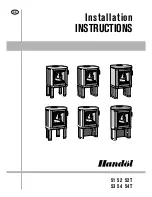
17
Oxford Direct Vent / Natural Vent Gas Heater
3-90-20306762
Vent Termination Below Grade
Install Snorkel Kit when it is not possible to meet the required
vent termination clearances of 12” (305 mm) above grade
level. The snorkel kit will allow installation depth of down
to 7” (178 mm) below grade level. The seven inches is
measured from the center of the horizontal vent pipe as
it penetrates the wall.
If the venting system is installed
below grade, a window well must be installed with
adequate and proper drainage. (Figure 28)
NOTE:
Be sure to maintain side wall clearances and vent
run restrictions. Refer to Figures 3, 4, 7, and 8.
1. Establish the vent hole through the wall.
2. Remove soil to a depth of approximately 16” (406 mm)
below the base of the snorkel. Install a window well (not
supplied). Refill the hole with 12” (305 mm) of coarse
gravel and maintain a clearance of at least 4” (102 mm)
below the snorkel. (Figure 28)
3. Install the vent system as described on Pages 14 - 16.
4. Be sure to make a watertight joint around the vent pipe
joint at the inside and outside wall joints.
5. Apply high temperature sealant around the inner and
outer snorkel collars. Join the pipes and fasten the
snorkel termination to the wall with the screws provided.
6. Level the soil to maintain a 4” clearance below the
snorkel.
ST1124
snorkel
Waterproof Seal
Around Pipe
Firestop
Window
Well
Drain
Snorkel
Termination
Cap
4” Clearance
Gravel
Figure 28
- Snorkel kit installation.
ST219
snorkel detail
12/6/99 djt
Recessed Wall
Firestop
Finishing
Collar
7” Pipe
Wall Plate
Sheet Metal
Screws and
Bracket
Wall Screws
and Anchors
Waterproof
Seal Around
Pipe
Figure 29
- Use extension brackets to mount snorkel against
recessed wall.
Vertical (Through the Roof) Vent Assembly
Note that all vertically terminated installations must include
the restrictor plate included with the stove. Refer to Figure 8.
Make certain the vent system conforms to all other
requirements for vertical termination as specified on Page 9.
This installation will require you to first determine the roof
pitch and use the appropriate vent components. Refer to
Figures 8 and 9.
1. Locate the final position of the stove, observing all
clearances for both the vent and the stove.
2. Plumb to the center of the inner (4”) flue collar from the
ceiling above, and mark that location.
3.
Cut the opening:
Hearth and Home Technologies System:
9-3/8" x 9-3/8" (240 x 240 mm)
DuraVent System: 10" x 10" (254 x 254 mm)
4. Plumb any additional opening through the roof or other
construction that may be needed. In all cases, the opening
must provide a minimum of 1" (25 mm) clearance to the
vent pipe.
5. Place the stove in its final position.
6. Install firestop(s) and Attic Insulation Shield as needed.
(Figure 30) If there is a room above ceiling level, a
firestop must be installed on both the bottom and top
sides of the ceiling joists. If an attic is above ceiling level,
an attic insulation shield must be installed.
7. Install the appropriate roof support and flashing, making
certain that the upper flange of the flashing base is below
the shingles. (Figure 31)
If the foundation is recessed, use extension brackets (not
supplied) to fasten the lower portion of the snorkel. Fasten
the brackets to the wall first, and then fasten to the snorkel
with self-tapping #8 x 1/2” sheet metal screws. Extend the
vent pipes out as far as the protruding wall face. (Figure 29)
















































